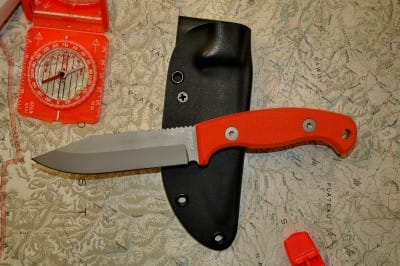J. Wayne Fears as seen on the Outdoor Wire

It is one of the most often asked questions in survival schools and seminars. “What is the best survival knife?” My usual answer is whatever knife you have with you at the time, but that usually brings on the next question, “If given a choice, describe the ideal survival knife, in your opinion.”
Having been both stranded and lost while on hunts during my 40- years of professional hunting experience, I have a very definite idea of the ideal survival knife. First, I consider that the knife will be used in a real-life survival situation. It is not going to be used for hand-to-hand combat, so that eliminates many of the large “Rambo” survival knives. It is, however, going to be used for digging fishing bait or roots, splitting a wet log to get to the dry center, skinning animals, punching holes in leather, cutting kindling and small sticks, making a shelter, prying rocks from a tube tent site and many other tough chores. In short, this must be a strong, well-made knife.
A Knife to Go the Distance
To get this strength, I like knives with a full-length tang. There is nothing worse than having a knife break into two pieces, just when you need it most. I have had this happen with a hollow-handled survival knife in which a tiny survival kit was stored in the handle.
The size of the survival knife is important. While it would be nice in many survival situations to have a machete, it is just not practical. The survival knife should be a fixed-blade knife, the size and design to be worn comfortably on the belt while hunting. I like an overall length of about 9 inches. Getting in and out of bush planes or canoes, off horses, and in and out of blinds is hard enough without having a large belt knife catching on everything. It should be useful for field dressing game and fish. If it is not a practical hunting/fishing knife, you can almost guarantee that it will not be on his belt when the hunter or angler suddenly finds himself in trouble.
Tough Handle, Sharp Edge
The knife’s handle needs to be made from a tough space-age material attached to the knife in such a fashion so that it can take a lot of abuse without coming apart. It should have a lanyard hole in the end that is large enough so that the knife can be hung up on a small limb or nail. Survival is a stressful time and a hunter under stress will quickly lose or misplace a knife. For this reason, I like a knife handle in a color which is easy to spot in leaves, grass, rocks, for example, a blaze orange. I also like a non-slip handle surface.

During a period of survival, keeping the knife blade sharp can be somewhat of a problem. Knowing this, many knife makers make their blades very hard, to hold the edge a long time, but when it comes time to resharpen it is almost impossible, especially in the field. I like a blade that is hard enough to keep an edge for many chores but soft enough to resharpen easily, even on a sandstone rock in the field. A 440C stainless steel blade with a hardness of HRC57 seems to work best for me. In stressful survival situations, the flat ground blade seems to be a little easier to sharpen than a hollow ground blade.
The blade design on the ideal survival knife needs to be a compromise between a drop point, which is designed primarily for dressing big game, and a spear point, which is designed for fine-cutting chores. I like the clip point for survival purposes because it is strong yet allows the user to do small, detailed chores, such as make gloves from a rabbit skin. The blade needs to be a little wider—1 1/8-inch and thicker than many belt knives available today to give it strength. The blade should be no longer than about 4½-inches to make it easy to carry.
Although there is no perfect survival knife, these features are, in my opinion, what is needed for a knife to be rated a practical survival knife.

Over the years, I have spent several unplanned nights in the woods, often with little more than a knife and a basic survival kit. Knives that have helped me make the situation safer and more comfortable have included a Foster Survival knife, Ka-Bar military utility knife, a Schrade 125OT, and a Leatherman Wave multi-tool. They, each in turn, were the knife I had at the time, and they all worked.
Your life may depend someday upon your choice of a survival knife. Give it some thought now, then select and carry a knife that will do the job when the time comes.



